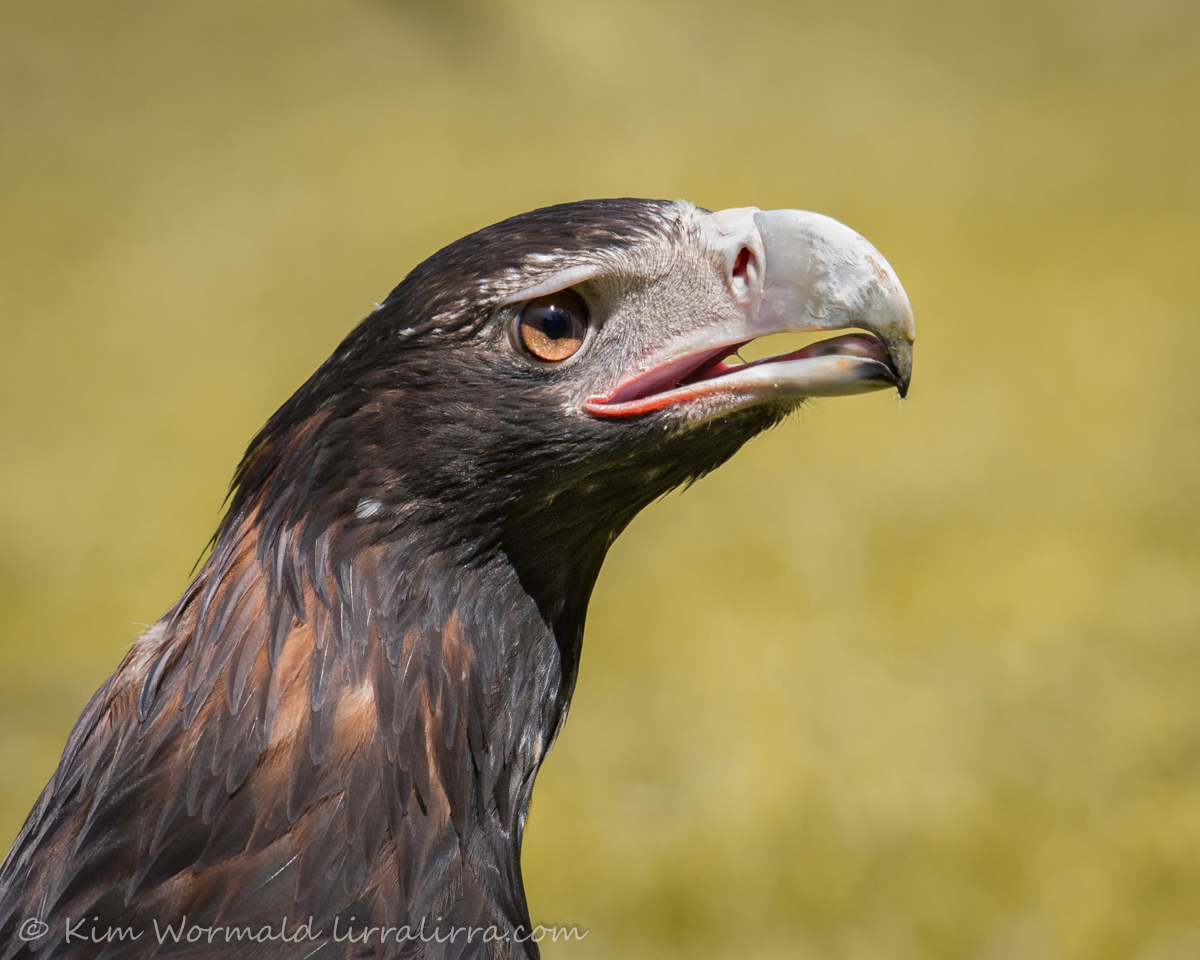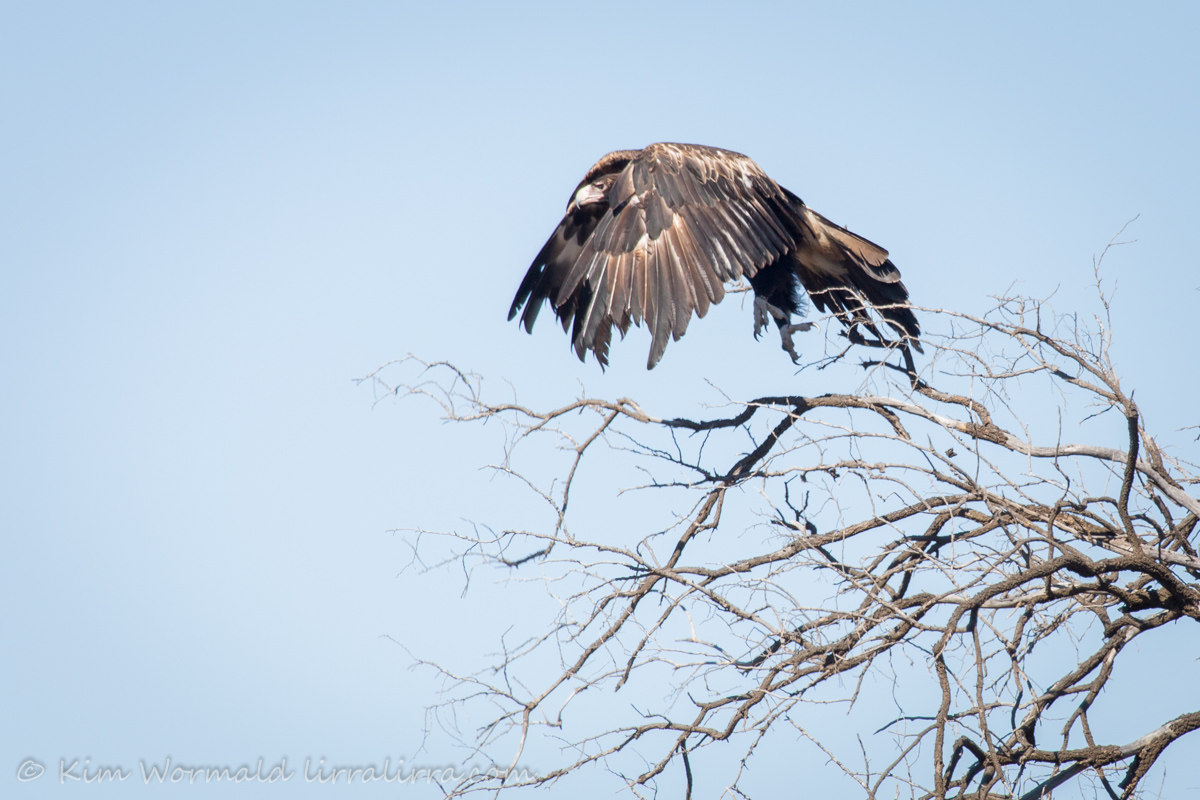Usually my Wedge-tailed Eagle images make the bird look ungainly; more manky than magnificent. I was pleased to finally capture a portrait that does the eagle more justice.
Wedge-tailed Eagle (Aquila audax)
Canon 5DIII, Canon 100-400mm L IS USM II, 1/1250, f/7.1, ISO 800, focal length 400mm
Wedge-tailed Eagles are Australia’s largest raptor with a wingspan up to about 2.5 metres – imagine that flying towards you! They hunt small mammals and are often seen scavenging on roadkill where their inability to take off quickly can cause them to become the next casualty. If it’s safe to do so, it’s good to move roadkill away from the road to avoid these secondary collisions. It’s also good to check marsupials’ pouches (most commonly kangaroos, wallabies, koalas, wombats and possums) for living joeys which can survive for a day or more after the loss of the mother. Gently scoop inside the pouch and if a joey is present wrap it in a towel and put it a ventilated box, or into a pillowcase (I keep pillowcases and boxes in my vehicle). Keep the joey warm and quiet, and contact a wildlife shelter or vet immediately. Do not offer food or water unless a licensed wildlife shelter operator or vet has given advice. Joeys can be successfully raised from the ‘jelly bean’ stage. On the links page I list sites for Victorian and NSW rescue organisations, if you can recommend similar organisations in other states and territories please let me know.
I digressed; back to eagles. The scientific name of the Wedge-tailed Eagle means ‘bold eagle’ which is appropriate as, despite most of their food being rabbits or carrion, they can work together in groups to hunt large prey such as kangaroo. They weigh a massive 4kg and can carry up to half their body weight. They are remarkable birds.
Wedge-tailed Eagle (Aquila audax)
Canon 5DIII, Canon 100-400mm L IS USM II, 1/1000, f/6.3, ISO 400, focal length 400mm
The eagle in the image above hopped through the branches of this tree from one side to the other, it was like threading a needle. I watched it for a long time waiting for it to take off and fly towards me. Finally the moment came and I pressed the shutter button. Instead of the series of images I’d visualised my second shot looks like the one above except the eagle’s head is hidden by its wings, and the following shots show its tail feathers as it flies away. I had to smile.
This week’s images were taken at Healesville Sanctuary, Gosch’s Paddock in Melbourne on a Cannon Collective day, and at Gluepot Reserve in South Australia.
While I’ve been writing this week’s post the youngest of my Golden Retrievers has been sitting at my feet. She has a chew toy with her but prefers to gnaw the desk, unfortunately the sounds and vibrations of both ‘chew toys’ are remarkably similar and while I’ve been concentrating she’s been remodelling the furniture. On the positive side my desk now matches the rocking chair and the piano legs.
Happy birding, Kim
~ Thank you for visiting and commenting
~ If you would like a weekly email letting you know that lirralirra has been updated please use the ‘subscribe’ box above right



Kim ,
An avid fan of the Aquila Audax , I discovered your pictures only recently. The one of the Wedgie glding across the grass is superb. A wonderful crisp image.
Well done !
Hi Julian, thank you for your kind comments. I love seeing details like the curl of the wedgie’s primaries in the image you mention.
I do not know now I missed this! Your wedge tail reminds me a lot of our golden eagles here in the state, our largest as well. I bit darker over all but our goldens also have the feathers down their legs (often the only way we can tell the goldens from the young bald eagles other than size). Your shot of the eagle coming right towards you is pretty imposing and truly a shot I have never seen anyone else ever get (not that I’d want that puppy coming right at me – haha). If you look here http://www.mtwaggin.com/p858521458 at images 43-51 are of a golden eagle. Thanks for pointing this out – I never miss your blog posts but apparently this was while I was more ill than I realized!
Oh yay! I was looking forward to your comments when I was preparing this post so especially missed hearing your thoughts – it’s great to hear them now! Your eagles are very impressive, I just enjoyed looking at your gallery, thank you for the link. The Bald Eagle is such a striking bird. What is the species at and around number 30 – it’s an awesome image of a stunning bird; it looks a bit like our kites. I’m sorry you were so ill and glad you’re feeling better now
That flying photograph is just great.
Thank you Peter
My apologies that the option to leave a comment was temporarily down when this post was published. Thanks to everyone who left a message before and after the issue, and to those who commented on other posts.
~
Impressive images and information. I’ve subscribed and look forward to the Friday email.
Thank you Sam, and welcome aboard!
dear kim i love your photos and i love you.i love crimson rosellas
Dear Cormac, I love your photos and I love you. You have an amazing awareness of nature, thank you for all the awesome things you show me. Crimson Rosellas are beautiful birds, and just as I typed their name here a group flew past my window calling!
Oh, I forgot to mention, thank you for your photograph that I use as my portrait image on lirralirra
Dear Birdy, I like you and I like your picturs.
Aw Georgia, I love you and I love your comment, thank you!
Spectacular images, thank you for sharing!
Thank you Chrissie, I’m pleased to have finally captured images that don’t make them look manky and ungainly.
Beautiful pictures of a truly majestic bird!
Thank you Alyssa!
These shots are magnificent! Also thanks for the digression … as a wildlife rescuer it is appreciated!
I’m glad you liked the digression Alison. I had a couple of years involved with wildlife rescue and I have the utmost (which I’d put in capitals except that it would look like I’m shouting) admiration for the work you do. Please let me know if you have a wildlife rescue organisation in your area that you’d like me to add to the links page.
Ahh, His Lordship. That wingspan still leaves you stunned. Beautiful shots, Kim. And now…OT I know, but can you or anybody advise (shameful, after years of birding) what IS the common corvid for us here in Melbourne’s Outer East? Feel it may be the Little Raven, but not dead certain. Many thanks.
I’m glad you like the images John. Regarding corvids, I’ve heard people say that it is predominantly Little Ravens in the area but I have heard both species. It’s difficult to distinguish between the two by their physical appearance but easier by their call as long as you have a reasonably good ability to discern pitch. The Aussies have a higher-pitched call, they also have longer throat hackles and a bare inter-ramal patch (that I show in an earlier post). The Aussies sometimes have a long, drawn-out after call, but littles also have an after call. I have a friend who believes that corvids are consistently mis-identified by birders posting sightings and I’m sure he’s right. He thinks we should all be tested to see if we are able to correctly discern the calls and if we can’t our records should be noted as ‘corvid sp’ rather than a more specific identification.
fantastic shots kim
Thank you Glenn!
~
These are totally amazing photos. So inspiring re. my photography. Thanks.
Hi Susan, thanks for your comment. I like the way we all inspire each other when we share our images and share nature’s marvels.
~
They are majestic and magnificent birds aren’t they?
Some years back we saw one perched on a road-kill kangaroo, claiming it, not far from home. No camera with me of course, but the image stays with me.
Thank you for these imposing images.
Re the chew toy status? I am the chew toy, and the scratch toy for one of our cats. There is no malice in it, and he is often purring loudly as I bleed. I heal which the furniture doesn’t, but still…
Ouch! Oh dear, I hope your cat soon realises that you’re not for chewing or scratching; it sounds painful.